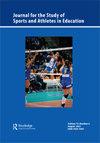An investigation of college student-athletes’ mental health stigma, help-seeking attitudes, depression, anxiety, and life stress scores using structural equation modeling
IF 1
Q3 EDUCATION & EDUCATIONAL RESEARCH
Journal for the Study of Sports and Athletes in Education
Pub Date : 2021-07-09
DOI:10.1080/19357397.2021.1924562
引用次数: 8
Abstract
ABSTRACT The purpose of this study was to investigate the directional relationship between student-athletes’ (N = 621) degree of mental health stigma, help-seeking attitudes, and levels of depression, anxiety, and life stress. The results of the structural equation model (SEM) analyses identified that student-athletes’ amount of mental health stigma contributed to help-seeking attitudes (25.6% of the variance), but not levels of depression (.16% of the variance), anxiety (.09% of the variance), or life stress (.81% of the variance). Specifically, student-athletes’ mental health stigma shared a strong negative relationship with attitudes towards seeking psychological help (β = −.506, p < .001) and the mediation models identified that personal stigma mediates the relationship between public stigma and help-seeking attitudes. Implications purport the need to address the stigma of mental health at the societal level in order to mitigate personal stigma and promote a positive sport culture surrounding mental health and health help-seeking within athletes.运用结构方程模型对大学生运动员的心理健康污名、求助态度、抑郁、焦虑和生活压力得分进行调查
摘要本研究旨在探讨学生运动员(N = 621)心理健康污名的程度、寻求帮助的态度以及抑郁、焦虑和生活压力的程度。结构方程模型(SEM)分析的结果表明,学生运动员的心理健康污名程度有助于寻求帮助的态度(25.6%的方差),但不影响抑郁(.16%)、焦虑(.09%的方差)或生活压力(.81%的方差)。具体而言,学生运动员的心理健康污名与寻求心理帮助的态度存在强烈的负相关(β = −.506,p < .001),并且中介模型确定个人污名介导了公众污名和求助态度之间的关系。其含义是,需要在社会层面解决心理健康的污名化问题,以减轻个人污名化,并促进围绕心理健康和运动员内部寻求健康帮助的积极体育文化。
本文章由计算机程序翻译,如有差异,请以英文原文为准。
求助全文
约1分钟内获得全文
求助全文
来源期刊

Journal for the Study of Sports and Athletes in Education
EDUCATION & EDUCATIONAL RESEARCH-
自引率
0.00%
发文量
25
 求助内容:
求助内容: 应助结果提醒方式:
应助结果提醒方式:


